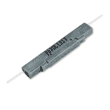|
|
| MAIN >> TECHNICAL JOURNAL >> SPLICING |
| PRACTICAL ECE: FIBER OPTIC SPLICING |
by Donats
Fiber Optic technology has emerged and established itself as one of the most promising electronic communications medium. Before this technology gained mainstream acceptance, copper wire and wireless communications account for most of the communications medium since these were the ones available at the time.
 | | Satellite technology, a predecessor of light wave communications. |
Copper wires include coaxial cables and twisted pairs (shielded or not) which are used in our LANs, telephone systems, internal circuitry of appliances, etc. While wireless or radio communication include the HF and VHF systems, microwave and satellite technology. Apparently, when everyone thought thereís no more room for another mode of communication, actually, there is. One that would give an entirely new and distinct set of advantages (and disadvantages) we all thought radio and copper wires already offer. First of all, fiber optic cables are interference resistant due to itís characteristic of utilizing light waves (as if you donít know! ECE ka, ndi ba?)). Second, limitations in distance and bandwidth capacity are addressed with fiber optic cables. It can span at distances much farther than coaxial cables, and transmit huge loads of information. Third, security is a non-issue for fiber optic cables since it cannot be tapped easily. And lastly, through the years, the cost of implementing this medium has significantly dropped (much like how PC prices fall over a span of time, minus the never-ending PC upgrades as fiber optic technology requires lesser frequent upgrades).
What weíre about to have is a basic introduction to FIBER OPTIC SPLICING. Weíve defined fiber optics, so now letís define splicing? Splicing in, laymanís term, simply means the joining of two fiber optic cables by reasons of extending an existing fiber optic cable, or expansion of an existing fiber optic cable system.
 | | Mechanical Splice - about the size of a large nail |
There are two major methods in splicing fiber optic cables: Mechanical Splicing and Fusion Splicing. Mechanical splicing is employed by using (quite obviously) a mechanical splice, an optical junction of two (or more) optical fibers that are aligned and held in place by a self-contained assembly. The ends of the fibers aren't permanently joined, but are only accurately aligned together so that light can pass from one to another.  | | Fusion Splicing Machine - good for many splicing works |
Fusion Splicing, on the other hand, requires the application of extreme temperatures by a fusion splicing machine (again, quite obviously) to melt up the two ends of the cable and join it permanently. Most fusion splicing machines have the ability to precisely align the ends of the cables automatically, which helps reduce the losses in light signals and back reflections incurred by misalignments of the two ends of the fiber optic cable. It takes a high percentage of accuracy to achieve this, that's why fusion splicing machines are quite expensive!
Each method has its own advantages and disadvantages.
There are three ways to sum up this situation:
Economics - Mechanical splices require no initial investment but have a higher utilization cost. You must buy another mechanical splice each time you make a splice. Fusion splices, on the other hand, require a large capital investment up front to purchase a fusion splicing machine. After that, the only consumable cost is in the protective device. Fusion splicing is a worthier investment if you intend to perform splicing in a long span of time.
Performance - Fusion splices typically provide lower loss and reflect less light than mechanical splices.
Fusion splicing, though, is a more tedious task to perfect than mechanical splicing.
Application - For most Local Area Network (LAN) applications, splice loss and reflections are minor concerns. However, splice loss must be minimized for most long distance communication and CATV applications. Also, high reflections can create serious problems for analog video signals. For these reasons, telecommunications and CATV companies almost always fusion splice. For LAN contractors, the choice between fusion and mechanical splicing remains primarily one of economics.
Before performing the splicing process, I suggest you read the webpage links below for a step-by-step and illustrated way of preparing the fiber optic cable to be spliced. Also in this webpage is the overview of performing fusion splicing. I hope this article has helped you understand and get a grip of fiber optic splicing. Now you can speak ECE because you know practical ECE!
For further education:
Preparing the cables to be spliced, and operating the fusion splicing machine - this webpage is from Corning Cable Systems, one of the pioneers in the fiber optic business. You might as well visit their website at www.corningcablesystems.com.
How Stuff Works : How Fiber Optics Work - a crash course on fundamental concepts that make fiber optic technology possible. A wonderful start-up guide for the non-ECEs!
Take the Fiber Optic Communications Online Test - this link is a practice test that checks your knowledge of the fiber optic technology.
|
 |
|
|